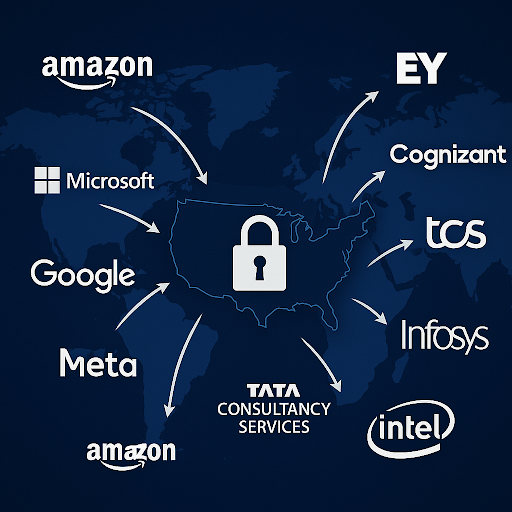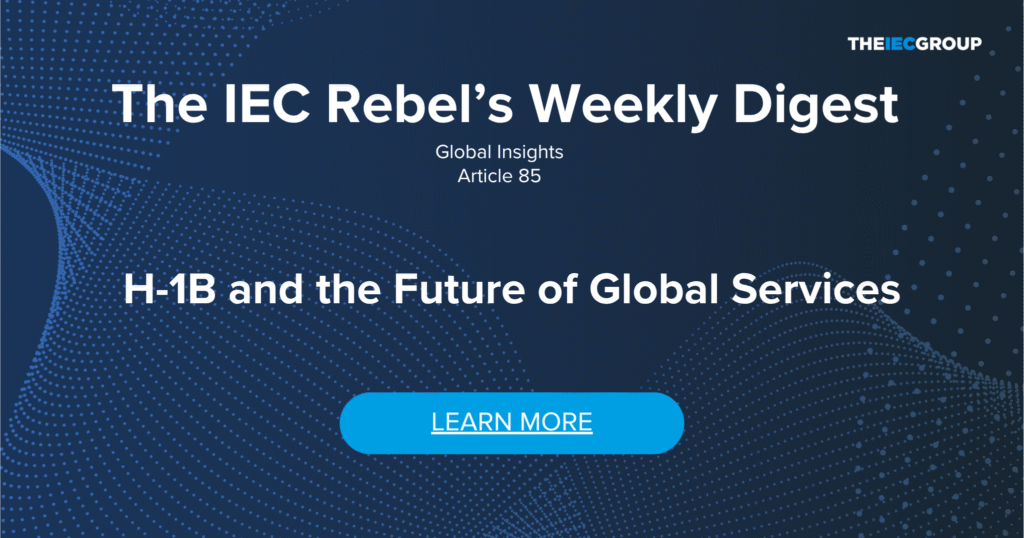H-1B and the Future of Global Services
Executive Summary
Executive Summary: The Premium Gate – H-1B and the Future of Global Services
 The U.S. has turned the H-1B visa from a competitive lottery into a premium gate. With a new $100,000 integrity fee on petitions filed from abroad, the cost of bringing international talent into the U.S. has skyrocketed. For large professional service firms—especially those built on rotational staffing and blended delivery models—this is nothing short of a business model shock.
The U.S. has turned the H-1B visa from a competitive lottery into a premium gate. With a new $100,000 integrity fee on petitions filed from abroad, the cost of bringing international talent into the U.S. has skyrocketed. For large professional service firms—especially those built on rotational staffing and blended delivery models—this is nothing short of a business model shock.
Our analysis shows that the biggest H-1B users are not just offshore IT providers. Amazon, Microsoft, Google, Meta, Ernst & Young, Cognizant, TCS, Infosys, and Intel all rank among the top sponsors. The impact cuts across tech, consulting, pharma, and manufacturing, reshaping how global firms approach U.S. expansion, staffing, and R&D.
The result? Fewer mid-level placements, more emphasis on premium talent, and a decisive pivot toward U.S.+ strategies: selective U.S. presence combined with nearshore hubs in Canada, Mexico, Costa Rica, and beyond. For emerging-market giants, survival now depends on platformized delivery, L-1/O-1 visa alternatives, sector specialization, and local M&A for credibility.
The U.S. remains a critical market—but it is no longer an open door. In our full Rebel’s Digest article, we explore how global service firms are recalibrating and what every multinational can learn from their playbook.
- Read the full article for free
Article 84 Service Giants Are Rewriting Their U.S. Playbook
The Premium Gate: How Emerging-Market Service Giants Are Rewriting Their U.S. Playbook After the H-1B Shock
The new rules of the game
On September 21, 2025, the U.S. overhauled the economics of skilled immigration with a $100,000 “integrity” payment attached to new H-1B petitions filed from abroad—a blunt policy intended to curb perceived abuse and tilt the program toward “top-tier” roles. Petitions already in process and many in-country changes of status were exempted, but for new, outside-U.S. sponsorships the message is unmistakable: enter if you must—at a price.
For years, the H-1B was a probabilistic headache—lotteries, wage levels, RFEs—but still a workable path for scaling U.S. delivery with international talent. The new fee transforms it from a compliance challenge into a capital allocation decision. Every sponsored head is, in effect, a six-figure bet before salary, benefits, legal fees, and relocation.
This change lands hardest on a specific cohort: large professional service firms from emerging economies that historically used rotational staffing and onsite consulting to anchor U.S. client relationships. These firms didn’t rely solely on H-1Bs—but H-1Bs were the pressure valve that made their blended onshore/nearshore/offshore model hum. The valve just got very expensive.
A market reality check: who actually uses H-1Bs at scale?
 The public narrative often fixates on “outsourcing” brands, yet the largest H-1B users span tech platforms, consulting partnerships, and IT services. Several datapoints from 2024–2025 make the picture clear:
The public narrative often fixates on “outsourcing” brands, yet the largest H-1B users span tech platforms, consulting partnerships, and IT services. Several datapoints from 2024–2025 make the picture clear:
- Amazon has consistently ranked among the top sponsors. A January 2025 roundup noted Amazon had the most approved petitions for initial employment in FY2024 (3,871); subsequent reporting in September 2025 put Amazon’s 2025 approvals at 10,044 (broader than “initials,” reflecting total approvals across categories).
- Mid-2025 coverage summarizing USCIS data again placed Amazon at #1, with Microsoft, Meta, and several big IT services/consulting firms close behind.
- Aggregators of LCA filings and approvals show a recurring cluster of top sponsors that includes Amazon, Cognizant, Ernst & Young, TCS, Google, Microsoft, Infosys, Meta, Intel, HCL America—spanning big tech, professional services partnerships, and systems integrators. (Methodological note: LCAs are intent-to-hire signals; approvals/initial approvals vary by definition and time frame, but the roster of heavy users is consistent.)
- The USCIS H-1B Employer Data Hub remains the primary source for employer-level data, and the agency’s annual Characteristics of H-1B Workers reports confirm the STEM-heavy mix that fuels tech, consulting, and advanced industry demand.
- A March 2025 Pew Research analysis found that IT and business service firms remained prominent among top H-1B employers; the composition has shifted over time but the sectoral dependence is intact.
Bottom line: the H-1B program is not a niche tool for a few outsourcing companies; it’s a backbone mechanism used by platform tech, the Big Four/Big Three consultancies, and global systems integrators to meet U.S. demand for specialized skills.
Why this hits emerging-market service firms differently
For large service firms headquartered (or historically scaled) in emerging economies, the onsite consultant has never been mere headcount; it’s been a commercial wedge—a way to build intimacy with U.S. client stakeholders, accelerate delivery assurance, and unlock follow-on programs.
The new fee torpedoes that model in three ways:
- Unit economics implode for mid-tier roles. An extra $100k is unrecoverable on commodity roles. Firms must elevate sponsored positions to scarce expertise—solution architects, sector SMEs, data/AI leads, security specialists—where project margins can absorb the fee.
- Demand timing no longer matches supply timing. Rotational deployments were a just-in-time lever; now they require big-ticket, board-level approvals. That slows response speed precisely when U.S. clients expect agility.
- Portfolio risk concentrates. If you can only afford to move a handful of people, any travel disruption, visa delay, or project cancellation magnifies risk. You lose the optionality that onsite benches once provided.
The pivot: five plays we’re seeing (and why they work)
1) “U.S.+” presence, not U.S.-or-bust
Firms are reframing the U.S. as a selective hub for client adjacency and go-to-market—not the center of gravity for delivery. The operating model becomes U.S. + nearshore + offshore, with the U.S. bench skewed senior and client-facing. Mexico City, Monterrey, Toronto, Vancouver, San José (CR), and Bogotá are the new time-zone mirrors that backstop U.S. accounts without crossing the H-1B paywall.
Why it works: preserves customer intimacy while shifting bulk execution to cost-effective, visa-light locations. It also de-risks against political swings in a single country.
2) Visa portfolio management (L-1, O-1) and green-card acceleration
Where internal transfers are viable, L-1 becomes the path of least resistance; for standout talent, O-1 is the premium lane. Existing U.S. employees see PERM/EB-2/EB-1 processes fast-tracked to reduce renewal exposure. None of these are “free,” but they avoid the $100k trigger in many scenarios and create stability for leadership talent.
Why it works: targeted, not wholesale. You reserve immigration effort for the people who genuinely drive revenue or IP.
3) Architect-led delivery and platformization
Firms are leaning into platform plays (industry accelerators, data products, compliance toolkits) that enable smaller U.S. teams to orchestrate large remote squads. One seasoned architect in Chicago can amplify a 60-person build team in Guadalajara or Manila if the delivery is scaffolded by reusable components.
Why it works: replaces people-throughput with asset-throughput—and that changes the immigration math.
4) Sectoral swing to complex, regulated work
With commodity staffing priced out, firms pivot toward regulated, high-margin verticals: financial services, healthcare, life sciences, industrial/energy, and public-sector modernization. These domains justify specialist visas and multi-year programs where amortization of entry costs is realistic.
Why it works: complex sectors value proximity, trust, and expertise—elements clients will pay for, even with tighter immigration costs.
5) M&A and acqui-hiring for U.S. beachheads
Buying boutique consultancies or product studios provides local delivery capability without visa friction. The calculus is changing: a $5–10M tuck-in that brings senior U.S. talent may be cheaper (and faster) than moving 50 mid-level engineers across a $100k toll gate.
Why it works: shortcuts the time-to-credibility with U.S. clients and reduces immigration dependence to surgical sponsorships.
Knock-on effects beyond services: manufacturing, pharma/biotech, advanced industries
The H-1B fee is not just a tech/consulting story. It ripples into the real-economy flywheel:
- Manufacturing & industrials. U.S. re-industrialization (semiconductor fabs, battery plants, robotics) depends on controls engineers, materials scientists, industrial AI, and equipment commissioning specialists. Many of these skills are globally scarce. If the U.S. path costs $100k per visa before pay, companies increase on-premise automation, deepen vendor embeds from nearshore hubs, or stand up R&D lines abroad to keep momentum.
- Pharma & biotech. Drug discovery and biologics manufacturing lean heavily on computational biology, biostatistics, process engineering, and QA/validation experts. Academic-to-industry pipelines often start with temporary status and convert to H-1B/green card. The new fee encourages firms to expand EU and UK trial ops or co-locate AI/omics teams in immigration-friendly countries to retain global talent.
- Automotive & smart mobility. EV platforms and ADAS stacks are multinational by definition. When U.S. entry is taxed, OEMs and Tier-1 suppliers reinforce Canadian, Mexican, and European centers for software-defined vehicle programs, importing only narrow bands of expertise into the U.S.
- Semiconductors. Fab ramp-ups mix local hiring with temporary waves of specialist technicians (tool install, yield, lithography, EHS). If each specialist triggers an extra $100k, fabs either bundle expertise via vendors (absorbing immigration in supplier contracts) or co-train U.S. apprentices faster—both affecting timelines and cost structures.
Research syntheses consistently show H-1Bs complement domestic labor and correlate with innovation and job creation in adjacent roles. If you dramatically raise the entry price, you also raise the friction for these adjacent flywheels.
The scoreboard: visible users and the optics war
Because the fee is so visible, policy messaging and PR matter. Headlines in 2025 repeatedly spotlight household-name sponsors:
- Amazon: largest H-1B sponsor by several recent counts (FY2024 initial approvals and overall 2025 approvals).
- Microsoft, Google, Meta: durable top-tier sponsors across engineering, AI, and cloud—representing high wage levels that fit the policy’s “premium talent” narrative.
- Consulting & assurance: Ernst & Young features prominently in LCA/approval aggregates, reflecting a mix of tech, analytics, audit, and advisory hiring.
- IT & systems integrators: Cognizant, HCL America and others remain among top sponsors across multiple datasets, underscoring enduring client demand for systems work.
The political backdrop remains volatile: lawsuits are already challenging the legality and speed of the $100k mandate, and industry groups warn of collateral damage to hospitals, universities, and advanced R&D. Whether courts narrow or pause the policy, executives should plan for a high-cost baseline with policy whiplash risk.
Playbook for emerging-market service giants: from survival to differentiation
- Redesign the U.S. role in the value chain
Think of the U.S. as front-of-house: business development, solutioning, regulatory navigation, and co-creation with client leadership. Delivery scale lives in nearshore/offshore factories; U.S. experts choreograph and assure.
Metrics to track: U.S. revenue per onsite head; velocity from proposal to SOW; percentage of programs governed by U.S. architects vs. staffed by U.S. commodity roles.
- Treat immigration like portfolio risk, not HR administration
Create a Visa Investment Committee (VIC) that green-lights sponsorships based on expected lifetime project value. If a candidate is a platform multiplier (e.g., a clinical data modeler who accelerates three pharma accounts), the $100k is justifiable. If not, route the role to nearshore.
Metrics to track: payback period per sponsored head; % of visas tied to multi-year, multi-account value; share of L-1/O-1 vs. H-1B.
- Codify expertise into assets
Every elite architect or SME should be productized: reference architectures, compliance accelerators, sector data models, playbooks. This shrinks the onsite team required to deliver transformation, and it raises price realization.
Metrics to track: asset-attached revenue; delivery effort variance after asset adoption; win rates linked to proprietary accelerators.
- Buy local credibility
Use small M&A to gain executive-level client access and scarce skills. Preserve the boutique’s brand and leaders; plug your global delivery engine underneath. Immigration becomes surgical—reserved for a handful of global champions.
Metrics to track: revenue uplift from acquired client logos; retention of acqui-hired principals; reduction in visas per $ of U.S. revenue.
- Build redundancy into nearshore
Don’t over-concentrate. Pair Mexico + Costa Rica, Canada + Colombia. Mirror critical roles across two sites to avoid single-jurisdiction shocks.
Metrics to track: SLA reliability under travel/visa disruptions; bench depth for security-cleared or regulated roles.
What it means for U.S. buyers of services
U.S. enterprises should expect fewer “bench” bodies onsite and more senior-lite squads: a principal architect and a client partner nearby, with most of the team remote. That can be higher quality if contracts shift from time-and-materials to outcomes and platforms. Procurement will see fewer junior resumes, more asset line-items, and a surge in nearshore travel in lieu of long-term U.S. placements.
For sectors like manufacturing and pharma, the vendor mix will include more equipment/OT specialists rotating in under supplier umbrellas and regulatory SMEs sponsored via selective visas—complemented by local hiring and apprenticeship programs to grow scarce skills domestically.
Scenario planning: what could bend the curve?
- Optimistic: Courts narrow the fee and/or agencies issue broad exemptions (e.g., for R&D, critical infrastructure, or accredited employers). H-1B remains viable for premium roles, and firms manage with VIC-style selectivity.
- Baseline: The fee persists for outside-U.S. petitions; wage-based selection tightens. Firms shift to U.S.+ models at scale, cutting H-1B reliance by 50–70% and backfilling with L-1, O-1, and green cards.
- Pessimistic: The policy broadens (or compliance burdens rise) and travel frictions escalate. H-1B becomes niche. Nearshore and European hubs capture investment intended for the U.S., with measurable consequences for innovation spillovers.
Rebel’s Take
The U.S. did not close its door; it put a premium lock on it. For large professional service firms from emerging economies, that means fewer, more senior visas—and a decisive pivot to asset-led delivery, nearshore redundancy, and selective U.S. presence. Firms that cling to onsite volume will bleed margin and optionality. Firms that rewire around architects, platforms, and portfolio-grade immigration will not just survive—they’ll differentiate.
IEC Rebel’s Digest— The IEC Group can help you audit your global employment setup by identifying labor leasing risks, verifying licensing requirements, and ensuring your EOR partners meet every compliance standard—before regulators come knocking.
Last but not Least: If you’re facing challenges and wondering how others are managing similar issues, why not join The Leadership Collective Community? It’s a peer group and webcast platform designed for leaders to exchange insights and experiences.
Introducing the IEC Knowledge Network Free Membership – Your Gateway to Seamless Access!
We are thrilled to present a new service that goes beyond the ordinary download experience. In addition to offering you the ability to download the things you love, we are delighted to introduce the IEC Knowledge Network Free Membership.
The Free Membership option grants you access to our library of articles and videos, without the need for tedious registrations for each piece of content.
The publication serves as a trusted resource to support executives in their pursuit of sustainable and successful global expansion. In addition the IEC Practitioners are available to discuss your specific challenge in more detail and to give you clear advise..
Take advantage of this valuable resource to accelerate your global expansion journey


